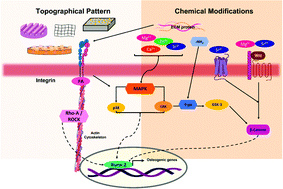Emerging modulators for osteogenic differentiation: a combination of chemical and topographical cues for bone microenvironment engineering
Abstract
Bone presents an intrinsic ability for self-regeneration and repair, however critical defects and large fractures require invasive and time-consuming clinical interventions. As an alternative to current therapy, bone tissue engineering (BTE) has primarily aimed to recreate the bone microenvironment by delivering key biomolecules and/or by modification of scaffolds to guide cell fate towards the osteogenic lineage or other phenotypes that may benefit the bone regeneration mechanism. Considering that bone cells communicate, in their native microenvironment, through biochemical and physical signals, most strategies fail when considering only chemical, geometrical or mechanical cues. This is not representative of the physiological conditions, where the cells are simultaneously in contact and stimulated by several cues. Therefore, this review explores the synergistic effect of biochemical/physical cues in regulating cellular events, namely cell adhesion, proliferation, osteogenic differentiation, and mineralization, highlighting the importance of the combined modifications for the development of innovative bone regenerative therapies.



 Please wait while we load your content...
Please wait while we load your content...